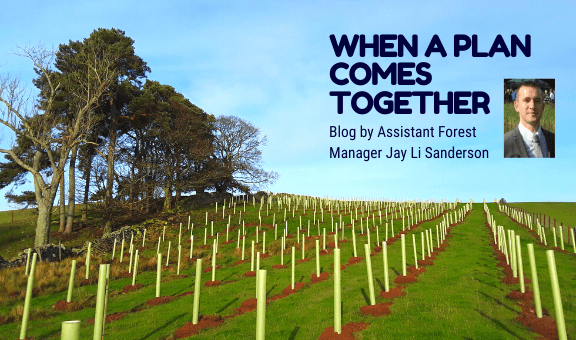A blog by North & Central Assistant Forest Manager Jay Li Sanderson.
As a lowland forester my area covers the east of England, ranging from the Humber to County Durham. In this area we lack many of the large-scale commercial conifer forests that I am sure our Forest Managers in parts of Wales, North West England, and certainly Scotland, are ecstatic to have as a part of their management portfolio. It is fair to say this lack of substantial conifer crops presents both pros and cons, but on balance it should neither be perceived as a negative or positive. What it does mean, in my experience, is that typically, as lowland Forest Managers we will manage a larger portfolio made up of often more diverse smaller properties than our conifer clad colleagues.
We often find ourselves tendering for quite a lot of relatively small pieces of work, these could range from one-hectare planting schemes; mechanical or chemical weed control; to short sections of fencing. However, these jobs all add up and soon fill our time so keeping us busy throughout the year with ever changing seasonal demands, which I have spoken about in my previous blog – which talks about the natural stratification of a forester year.
Of late, Tilhill Forestry has been collaborating with The Woodland Trust to deliver on the MOREwoods Initiative. We have recently been involved with two schemes which are quite similar in that the land for both planting schemes has been removed from grazing regimes by the current owners; planted up with a long-term vision of woodland creation – a commendable action in the eyes of a forester!
The first project was a woodland creation scheme in County Durham. It was designed specifically to tie into existing planting to the west of our site, largely for bio-diversity and habitat extension with no commercial interest. This is an interesting job with three sides of the nearly four-hectare moorland site bounded by a Site of Special Scientific Interest (SSSI). As such, an Environmental Impact Assessment (EIA) was required at the planning stage. The species mix was solely native broadleaf tree, and shrub species planted randomly in species specific groups as the remit of this woodland was legacy planting in order to provide amenity for the landowner.
Secondly, and more recently, we have become involved with a woodland creation scheme near York specifically designed to add amenity value to the landowner’s equine operation; again, with no commercial interest. This job was quite interesting as the plethora of open glades and rides designed to allow ease of access on horseback in later years provided potential to create a feathered shrub lined woodland edge which would hopefully act as a magnet for wildlife and increase bio-diversity locally.
Also, of interest with this site was the fact that on first inspection it seemed to be bowling-green flat. Its microtopography and ranging soil types were very interesting. Whilst the site’s superficial geology was largely impermeable and poorly draining, flattened spoil heaps from the adjacent fishing lake had obviously been excavated reasonably recently creating slightly raised benches across the site; these areas were much more unconsolidated and free draining. The species mix comprised of native broadleaf trees and shrub species planted in accordance with the knowledge of soil types on site.
Whilst inter-organisational collaboration with the Woodland Trust has certainly provided some interesting jobs in recent months, we have also completed many jobs with a broad host of organisations over recent years including the North York Moors National Park Authority. Regardless of the organisation that we are working with, there are always a lot of pieces of the puzzle to move into place, whether it is delivery of trees; protection of stock; land access agreements; financial agreements or any other detail. It is often a challenge but it always works out well and it does feel good when a plan comes together!



